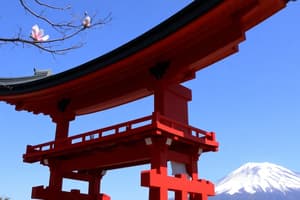Podcast
Questions and Answers
What are the two traditional methods of finding a partner for marriage in Japan?
What are the two traditional methods of finding a partner for marriage in Japan?
- Omiai and Ren'ai (correct)
- Mukae-bi and Okuri-bi
- Jizo and Shinto
- Butsudan and Obon
In Japan, most weddings are held following traditions of which two cultures?
In Japan, most weddings are held following traditions of which two cultures?
- Buddhist and Hindu
- Taoist and Sikh
- Islamic and Jewish
- Shinto and Christian (correct)
What annual festival in Japan is dedicated to honoring the spirits of ancestors?
What annual festival in Japan is dedicated to honoring the spirits of ancestors?
- Omiai
- Butsudan
- Ren'ai
- Obon (correct)
What cultural aspect of Japan involves actions for the dead being done in a way opposite to daily life?
What cultural aspect of Japan involves actions for the dead being done in a way opposite to daily life?
Which term refers to the Japanese culture of deliberately performing actions for the dead in an opposite manner to everyday life?
Which term refers to the Japanese culture of deliberately performing actions for the dead in an opposite manner to everyday life?
What type of marriage involves a husband and wife meeting on their own and deciding to marry?
What type of marriage involves a husband and wife meeting on their own and deciding to marry?
What is the primary meaning of the Japanese term "Matsuri"?
What is the primary meaning of the Japanese term "Matsuri"?
Why are certain ideas, symbols, and practices carried on in festivals?
Why are certain ideas, symbols, and practices carried on in festivals?
Which of the following is NOT a type of festival mentioned in the text?
Which of the following is NOT a type of festival mentioned in the text?
What is the significance of the Obon festival?
What is the significance of the Obon festival?
How is the Obon festival regarded in Japan?
How is the Obon festival regarded in Japan?
What does the term "Golden Week" refer to?
What does the term "Golden Week" refer to?
What is the main purpose of Matsuri (Japanese cultural festival)?
What is the main purpose of Matsuri (Japanese cultural festival)?
What belief do the Japanese hold about Gods according to the text?
What belief do the Japanese hold about Gods according to the text?
Why do many Japanese people enjoy Matsuri festivals?
Why do many Japanese people enjoy Matsuri festivals?
In Japanese culture, what is the significance of the Emperor presently?
In Japanese culture, what is the significance of the Emperor presently?
What is the main focus of Matsuri (Japanese cultural festival) according to the text?
What is the main focus of Matsuri (Japanese cultural festival) according to the text?
What is the main reason Japanese Matsuri festivals are considered significant?
What is the main reason Japanese Matsuri festivals are considered significant?
What is the meaning of the word 'Obon'?
What is the meaning of the word 'Obon'?
When is the festival of Obon usually held?
When is the festival of Obon usually held?
What is the significance of the 'welcoming fire' during Obon?
What is the significance of the 'welcoming fire' during Obon?
What is 'Bon Odori'?
What is 'Bon Odori'?
Which Japanese festival is related to Obon according to the text?
Which Japanese festival is related to Obon according to the text?
'Hanabi' in Japanese refers to what?
'Hanabi' in Japanese refers to what?
During which period did the major change in the history of kimonos occur?
During which period did the major change in the history of kimonos occur?
What is the significance of the term 'kimono' during the Kamakura and Muromachi periods?
What is the significance of the term 'kimono' during the Kamakura and Muromachi periods?
What did the ruling class refer to as 'o-sode' during the Heian period?
What did the ruling class refer to as 'o-sode' during the Heian period?
Which garment symbolized the ruling class of the Heian period?
Which garment symbolized the ruling class of the Heian period?
What garment is described as a 'kimono with a tsutsusode attached' in the text?
What garment is described as a 'kimono with a tsutsusode attached' in the text?
What term was first coined during the Kamakura and Muromachi periods to distinguish certain garments?
What term was first coined during the Kamakura and Muromachi periods to distinguish certain garments?
Flashcards are hidden until you start studying




